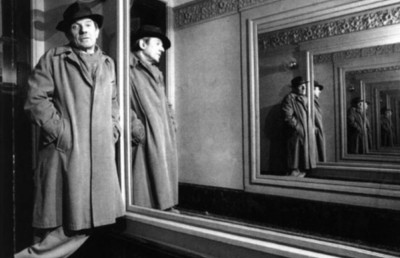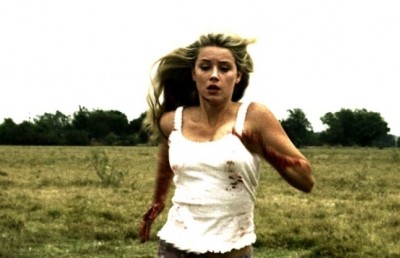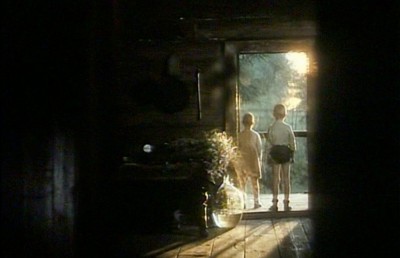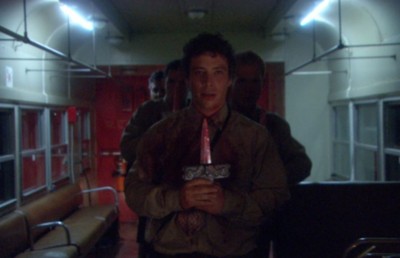Seeing, Thinking, and Writing: Daniel Shaw’s book Film and Philosophy: Taking Movies Seriously
Films are philosophical in different ways
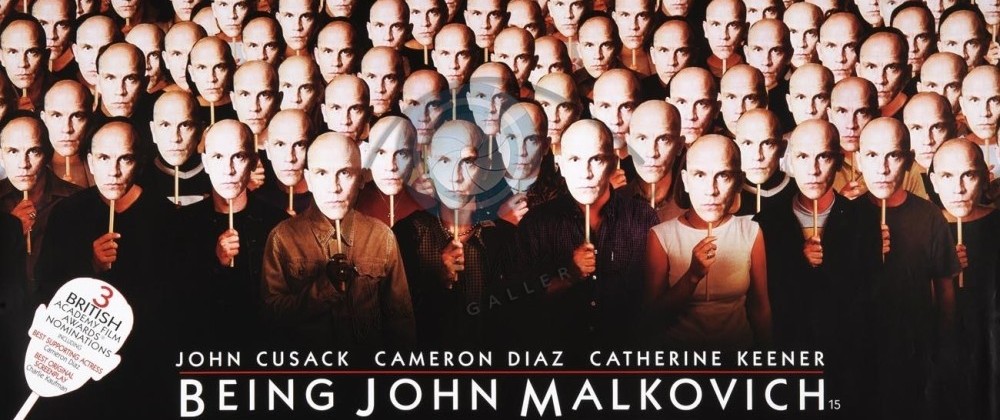
Film and Philosophy: Taking Movies Seriously
By Daniel Shaw
Wallflower, London and New York
132pages (pbk); 2008
ISBN 978-1-905674-70-1

Doing Philosophy at the Movies
By Richard A. Gilmore
State University of New York Press
Albany, NY
183 pages (pbk); 2005
ISBN 0-7914-6392-3
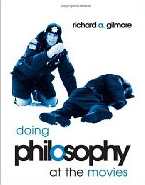
Philosophy is often abstract, whereas art is often about the relationship between or among specific entities—whether aesthetic relation or social relation, art is more likely to be about things and philosophy about ideas, though both disciplines do share a beginning in human imagination. Each discipline has its own language. How do we question a discipline in a way that is creative, constructive? How do we enlarge knowledge about human consciousness and its choices? How do we recover and protect the self in a world of extensive power and surveillance? Daniel Shaw’s book Film and Philosophy is a thoughtful introduction to examining how philosophy responds to films, and how films explore philosophical ideas.
The academic study of film “took root at American universities in English departments,” possibly because of the appeal of narratives, of story-telling, and that study concerned critical theory and the nature of film (page 1); but since then films have become more a part of the study of philosophy, thanks to the work of professors such as Stanley Cavell and Noel Carroll (page 2). In Film and Philosophy: Taking Movies Seriously Daniel Shaw states that there are different ways that films can be philosophical; and that the films that parallel major philosophies are philosophical, and that articles that focus on those examples are philosophical too: included can be films focused on the disciplines and insights of psychology, sociology, linguistics, and philosophy. For example, The Photoplay by Hugo Munsterberg was on psychology and cinema, and also aesthetics: “To imitate the world is a mechanical process; to transform the world so that it becomes a thing of beauty is the purpose of art,” said Munsterberg (quoted on Shaw’s page 8). As well, the theorist and film director Sergei Eisenstein recognized cinema as providing images that stimulate emotion which in turn inspires ideas; seeing cinema as something developmental, as uniquely capable of developing a thought; and, as many people know, Eisenstein saw the pictorial montage as able to carry intellectual complexity, both complement and conflict. Consequently, Daniel Shaw considers how art has been thought to embody emotion, touching audiences, bringing them close to the emotions that may have inspired the art itself, offering the capacity to transform audiences and their minds (10).
Cinema was able, is able, to reflect the inner dimension and the public or social world; and its attentive and thoughtful viewers celebrate that, as Daniel Shaw summarizes in Film and Philosophy: Taking Movies Seriously. Film critic André Bazin perceived cinema as an able presenter of reality and considered the deep focus long shot as an ideal (he particularly liked Jean Renoir’s work); and Offscreen’s editor Donato Totaro’s succinct summary of Bazin’s perspective is quoted in Daniel Shaw’s text (12). Siegfried Kracauer’s Theory of Film: The Redemption of Reality argued that films’ potential to capture the flow of life is a unique, admirable quality (13). There is, also, an acknowledgement of the debate over realism versus expressionism, and more than one example of how something strange could burst through a mundane representation of reality. Robin Wood’s use of psychoanalysis in examining horror films, and commentary on homosexual subtext in the film Raging Bull, and assertion of the importance of Marxist-Freudian synthesis are seen as important influences in the development of film criticism and on the reception of genre films (14-16): and some of the insights could be startling—for instance, Robin Wood discussed how men project their own attraction to males onto the woman they’re involved with, becoming irrationally jealous, an insight for both film and life.
Social issues do not leave us upon entering the film theater, though we might want it otherwise. The politics of cinema can be treacherous, wearying, especially as that is sometimes not fairly or honestly faced by film critics whose responses are fundamentally political (such as when they feel politically indicted or threatened by a particular film but respond with aesthetic charges). The controversy over Michael Cimino’s film Heaven’s Gate was partly rooted in its politics, in a film that suggested a Marxist critique of American society (16). Class, gender, and race remain controversial, though there are ways of pretending the controversies do not exist or are being managed properly by society, art, or philosophy. Laura Mulvey’s influential work was on looking, and on woman as object (the further insight: men do not want to see men as objects, but only as active agents). Yet, there can be theoretical capitulation to a new insight without changing our practical responses (we can know it is a limitation to see women as objects and continue to see women as objects).
In Film and Philosophy: Taking Movies Seriously, Daniel Shaw states that philosophers such as Suzanne Langer, Arthur Danto, and, especially, Stanley Cavell helped to pioneer addressing films from a philosophical view. “Like Wittgenstein, Cavell solves many of the problems of essentialist philosophy by simply circumventing them, or rendering the questions meaningless” (21). (Of course circumvention does not strike me as a solution but, rather, a strategy. Rendering them meaningless is more.) Cavell’s philosophical film focus has been love and marriage, with the doubtful permanence of marriage, and the possibility and comedy of remarriage (22). (Until one is married to a person, one does not have to knowledge to be married to that person.) Cavell sees that a subjectivity that is not particularly valued by politics or religion is affirmed in remarriage comedies (24); and, thus, philosophy can “help us become who we are” (26).
One of the benefits of reading Film and Philosophy: Taking Movies Seriously is being reminded how one person’s contribution becomes the wealth of all. “Good aestheticians have a fine eye for detail, a delicacy of taste that they can articulate to their readers. One of our best screen aestheticians in this sense of the term is Noel Carroll,” writes Shaw (27). Noel Carroll defines horror, explains its effects, lists plot possibilities, and explicates the attraction of horror in its engagement of the repulsive (28). The contents of imagination, of thoughts, whether they correspond to real world beings and events, affect us. “Curiosity is at the heart of most narratives,” and there is a drama of detection at work in horror films (29). Carroll is profiled as advocating cognitive science as a basis for philosophical exploration of film, and against psychoanalysis, aesthetic theories, and strict formalism, rejecting theories about the fundamental nature of cinema (30). Genre distinctions are considered good, useful, according to Carroll (whether a film is true to a genre rather than being true to some idea of the essence of cinema). Horror becomes a way of treating otherness, a form of imaginative play between normality and monstrosity, a way of dealing with ambivalent impulses toward conformity and rebellion (36). The limits of Carroll’s theory of horror may be his focus on monstrosity, his denial of pleasure in horrifying beings, and his seeing only monsters as horrifying (38). (Sometimes the monster gratifies a desire for a powerful, rebellious figure; and sometimes normal routine humanity is terrifying.) Cynthia Freeland, for one, argues that it is embodied evil that is horrifying; and that horror-viewing is an opportunity to contemplate evil (38). Daniel Shaw thinks we enjoy identifying with evil, with the monster, that we enjoy the thrill of that forbidden power (40).
Another film form grounded in the imagination and in speculative thought is science fiction, which gives vision to our hopes and fears for the future. “Science fiction is the most philosophical of literary genres,” in its concern with personal identity, technology, the future, and other beings, asserts Shaw (44), who goes on to summarize responses to popular films such as The Matrix and Blade Runner and the Aliens series starring Sigourney Weaver.
How important are the hopes and fears we bring to film? The philosophical approach to emotion in cinema, with our imaginative sympathy to fiction, suggests that emotion can be shared, that emotion is contagious: films create moods that make certain emotions more likely, suggests Greg M. Smith; and Alex Neill makes a distinction between sympathy and empathy, with empathy involving more direct identification (51-54). (There has been scientific research into the responses of neurons, and how watching an act—real or symbolic—inclines a certain amount of identification, as if we were involved, as if we were performing an act.) Cinema provides news, speculation, imagination, thought—and catharsis. However, the film thinkers David Bordwell and Noel Carroll, two cognitive philosophers, are less interested in stories than many, and are wary of interpretations that involve established narrative explanations, such as those relative to Marx, Freud, or Derrida and their disciples (63). They, Bordwell and Carroll, seem concerned with conventions, attuned to traditional forms and genres. Whereas, Daniel Frampton encourages attention to cinematic properties, to movement-image and time-image, to how films think; and, while interested in film technique, Frampton remains open to various forms of interpretations, including that of film and social theories (65-66).
There are different philosophical avenues in the cinematic realm’s understanding and treatment of emotion, meaning, and morality as they relate to the individual and his (her) relation to others: The existential philosopher Jean-Paul Sartre thought of love as contradictory, acknowledging that we as lovers wanted to both dominate our beloved and to be chosen by an equal; and Sartre considered our desire for love self-defeating, a matter of bad faith. Sartre, who liked cinema, influenced critics and filmmakers, including André Bazin, Woody Allen, and Louis Malle. Kevin Stoehr delineates the difference between a passive, pervasive nihilism that denies all meaning, and an active nihilism that is used as a critical strategy to destroy old meanings and establish new meaning (69). Film noir is nihilistic, often passively so. Difference is recurring: Plato evaluated works regarding morality, and Kant evaluated works regarding aesthetics; and philosophers can take either or both positions to one extent or another (74). Films such as Groundhog Day and The African Queen show the possibility of self-correction and self-improvement, morality in action.
In Film and Philosophy: Taking Movies Seriously, forms of social thought—critiques of race, class, and gender—are summarized. There are films that philosophize by provoking questions, one case being Spike Lee’s Do the Right Thing, which deals with racial conflict and personal responsibility; and some films are seen as failed philosophical explorations, for an inability to offer a rich experience, a genuine exploration of another culture, one case being Bertolucci’s The Sheltering Sky (86-88). That Spike Lee’s work would be preferred to Bertolucci’s suggests something about how precarious, how unpredictable, is the intellectual evaluation of art. It is noted as well that regarding class, regarding economic relations, in film, individual aspirations of upward mobility are often affirmed, while group hindrances (and group protests) are not often sympathetically shown or valued. In terms of the images of women, or of women as objects, there can be negatively reactionary aspects in the films one would expect to be progressive, and liberating aspects in films one might expect to be conservative. As examples, some horror films are seen as subversive of patriarchy and some popular films (Silence of the Lambs, for one) are seen as conservative in their presentation of the female character’s relation to men (93-95). In Silence of the Lambs, women are victims and even the woman police officer must go to a criminal male for help in solving a case. Daniel Shaw asks a provocative question (97): can feminists describe sexual equality in a way that makes it attractive to all?
What is an ideal relationship? How does one see a woman’s value, or a man’s value? Of course, Stanley Cavell is returned to at different points in the text, including in regard to gender. The romantic past of two people, a woman and a man, and their genuine struggles with each other, their knowledge, and current appreciation, are important in Stanley Cavell’s lauded comedies of remarriage (98). Cavell’s focus on love and marriage is aesthetic, philosophical, and social. It is a focus that can be useful to ordinary people. Yet, Tom Wartenberg sees the class connection between lovers, with class as a binding force (101). Love affairs in film—especially between people from different social groups—allow the audience to face and sometimes move beyond its prejudices. How does one evaluate a lover’s value? Comparison, contrast, and choice are all part of intellectual, personal, and social evaluation.
Philosophical representations and summaries can be less rigorous than asking—through the evolution of a scenario, through acts and their effects and contemplation—fundamental questions about human existence, according to some thinkers and filmmakers. Experience can educate and corrupt. Some films are philosophy in action: Louis Malle’s Le Feu Follet in its treatment of suicide (will he or won’t he and why?), with its unpredictable end; Charlie Chaplin’s Modern Times, with its view of mechanized modern labor; and Spike Jonze’s Being John Malkovich, with its visualization of complex identity (104-108). How do we maintain or regain a sense of possibility, of value? What is it to be human? How far do we accept what we do not know and cannot control? Reading Daniel Shaw’s Film and Philosophy: Taking Movies Seriously it is impossible not to conclude that different kinds of films have different uses and significance for philosophy (111). His book, one of clarity and concision, works as a basic introduction and summary of philosophy’s response to film. It is a respectable addition to the shelf of books produced on film and philosophy in recent years; and yet, it makes me long to read once more Richard A. Gilmore’s Doing Philosophy at the Movies.
In Doing Philosophy at the Movies, Richard A. Gilmore looks carefully at a film such as The Searchers and finds things many might not see at first glance: it is a movie in which the lead character, Ethan, is fooled by a Comanche trap, and has trouble locating his abducted and presumably assaulted niece, making him a failed or failing hero. Is it that he cannot find his niece, or that he doesn’t want to find her? Human beings can be beautiful, intelligent, and true, but are frequently a mess, and that mess shows up in art and some philosophers—such as Richard A. Gilmore in Doing Philosophy at the Movies —are able to untangle that. With evidence found in the film itself, Gilmore speculates that the long journey of The Searchers lead character has been, actually, for self-acceptance, for reconciliation with his own loss and pain (and his thoughts of vengeance and murder have been inadequate responses to that pain). Richard Gilmore notes how Ethan’s alienation puts him in a philosophical position: “The philosopher must stand outside society in order to understand the forces that impinge upon us as members of a society, of a community” (26). In Doing Philosophy at the Movies, the eloquent Concordia College philosophy professor, Gilmore, does more than summarize what a philosophy of movies might be like: he demonstrates it, as he discusses The Searchers, The Usual Suspects, Vertigo, Fargo, Crimes and Misdemeanors, The Terminator, 12 Monkeys, Trainspotting, Night of the Living Dead, and The Matrix. With a language of genuine depth and easy splendor, Gilmore shows how there is an idea, a story, an understanding, beneath the obvious story in a film—significant understandings that correspond to, and even expand, established philosophical concerns. In the seven essays devoted to film exploration in Doing Philosophy at the Movies, Gilmore brings together some distinctive films and illuminates them with the ideas of John Dewey, Martin Heidegger, Nietzsche, Charles Sanders Pierce, Plato, Richard Rorty, and Wittgenstein, among other thinkers.
Gilmore examines the film The Usual Suspects, focused on a search for a great criminal, and also Vertigo: both are films of deception and detection. In the former, a policeman learns late that his is not the only mind, when he himself is outsmarted. In Vertigo, the story involves a man’s infatuation with a woman, but the film is also about the nature of reality and illusion. The nature of reality, like the existence of other minds, is a classic subject in philosophy. In Vertigo, Scottie sees an image of Madeleine and compels Judy to be that image, insisting that a lie be made true: and she seems willing to sacrifice herself for his illusion. Scottie’s vertigo is part of his discomfort with himself, his discomfort with his being in the world, with reality, according to Richard Gilmore. How do we reconcile ourselves to reality; and what are the consequences for ourselves and others if we do not? That question is, also, answered badly by desperate Jerry Lundegaard in the movie Fargo. “I see the character of Jerry Lundegaard as enacting the wrong way to grasp the American sublime and the character of Marge Gunderson as enacting the right way,” declares Gilmore in Doing Philosophy at the Movies (61), of Jerry, who wants his wife kidnapped in order to extort money from her wealthy father. What is of genuine value? Marge Gunderson, the well-rounded police officer, sees through the ruse, and solves the enacted crime: she has a critical perspective, a moral sense. It is that philosophical aspect we could use more of.
Philosopher Richard Gilmore casts his eyes on science fiction; and interprets The Terminator, about a robot terminator’s intent to kill a future leader, and 12 Monkeys, about a return to the past for the locating of the origins of a catastrophic virus, seeing both films as offering representations of threat and deliverance. (These visions of the feared future could be seen as allegories of the present.) Gilmore recalls Jean-Francois Lyotard’s thoughts on capitalist control of people’s lives and the resulting terror, and how that matches Martin Heidegger’s sense of social control leading to false lives: and, an excess of control, attended by violence, is what Gilmore sees in The Terminator and 12 Monkeys. Gilmore does not forget that what is at stake in both film and philosophy is the human being. As well, Richard A. Gilmore finds classical subjects and themes in other works: he connects Night of the Living Dead with the hell of Dante, and with Odysseus in the house of the dead in Homer’s Odyssey (and with the musings of various philosophers)—it is a confrontation with death that they all share: death which chases us all, death which we must each find a way of welcoming. The Matrix, which includes philosophical dialogue, is about sleeping and waking, knowing and accepting. That beautiful, visionary, and wild film, like Richard A. Gilmore’s book Doing Philosophy at the Movies, is fun.


